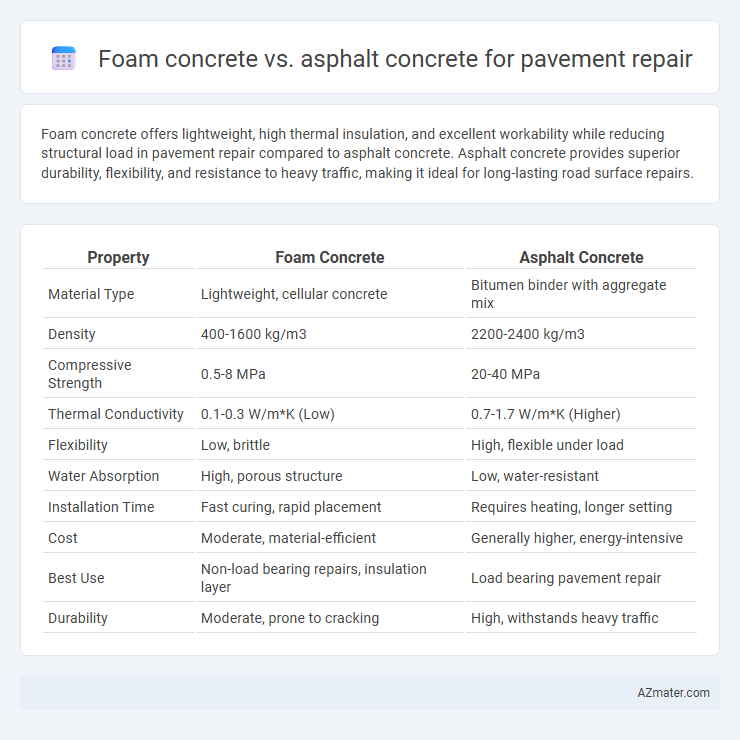Foam concrete offers lightweight, high thermal insulation, and excellent workability while reducing structural load in pavement repair compared to asphalt concrete. Asphalt concrete provides superior durability, flexibility, and resistance to heavy traffic, making it ideal for long-lasting road surface repairs.
Table of Comparison
| Property | Foam Concrete | Asphalt Concrete |
|---|---|---|
| Material Type | Lightweight, cellular concrete | Bitumen binder with aggregate mix |
| Density | 400-1600 kg/m3 | 2200-2400 kg/m3 |
| Compressive Strength | 0.5-8 MPa | 20-40 MPa |
| Thermal Conductivity | 0.1-0.3 W/m*K (Low) | 0.7-1.7 W/m*K (Higher) |
| Flexibility | Low, brittle | High, flexible under load |
| Water Absorption | High, porous structure | Low, water-resistant |
| Installation Time | Fast curing, rapid placement | Requires heating, longer setting |
| Cost | Moderate, material-efficient | Generally higher, energy-intensive |
| Best Use | Non-load bearing repairs, insulation layer | Load bearing pavement repair |
| Durability | Moderate, prone to cracking | High, withstands heavy traffic |
Introduction to Foam Concrete and Asphalt Concrete
Foam concrete is a lightweight, aerated material composed of cement, water, and foam, offering excellent thermal insulation and reduced dead load for pavement repair applications. Asphalt concrete consists of aggregate bound by bitumen, providing high durability, flexibility, and resistance to cracking under traffic loads. Selecting between foam concrete and asphalt concrete depends on factors like load-bearing requirements, environmental conditions, and repair longevity.
Material Composition and Properties
Foam concrete comprises a cementitious matrix with air bubbles introduced through foam agents, resulting in low density and high insulation properties, making it ideal for lightweight pavement repairs. Asphalt concrete consists of bitumen binder mixed with mineral aggregates, providing high strength, durability, and flexibility essential for handling load stresses in road surfaces. While foam concrete offers excellent thermal insulation and reduced dead load, asphalt concrete delivers superior skid resistance and resistance to deformation under traffic loads.
Installation and Application Methods
Foam concrete offers lightweight properties and excellent flowability, making it suitable for filling voids and stabilizing subgrades with simple pumping and casting methods. Asphalt concrete requires hot-mix production and vibration compaction, demanding higher temperatures and specialized equipment for installation. Foam concrete is preferred in areas needing rapid curing and minimal traffic disturbance, while asphalt concrete excels in high-traffic pavements due to its durability and flexibility.
Strength and Durability Comparison
Foam concrete offers lower compressive strength compared to asphalt concrete, making it less suitable for high-traffic pavement repairs requiring heavy load-bearing capacity. Asphalt concrete provides superior durability with high resistance to deformation, fatigue, and weathering, ensuring longer service life in road surfaces. Despite foam concrete's lightweight and insulation benefits, asphalt concrete remains the preferred choice for strength-critical pavement repair applications.
Thermal and Acoustic Insulation Qualities
Foam concrete offers superior thermal insulation qualities due to its lightweight, cellular structure, which reduces heat transfer and helps maintain surface temperature stability in pavement repairs. Asphalt concrete, while durable and flexible, has lower thermal insulation properties, leading to higher heat absorption and surface temperature fluctuations. Acoustic insulation is more effective in foam concrete as its porous composition absorbs sound vibrations better than the dense, compact nature of asphalt concrete.
Environmental Impact and Sustainability
Foam concrete offers significant environmental benefits over asphalt concrete by utilizing industrial by-products such as fly ash, reducing the demand for natural aggregates and lowering carbon emissions during production. Its lightweight and porous structure enhance water permeability and reduce urban heat island effects, promoting sustainability in pavement repair. In contrast, asphalt concrete relies heavily on petroleum-based binders and generates more greenhouse gases, making foam concrete a greener alternative for long-term infrastructure resilience.
Cost Effectiveness and Budget Considerations
Foam concrete offers significant cost savings in pavement repair due to its lightweight nature, reducing transportation and labor expenses compared to asphalt concrete. Asphalt concrete, while providing a durable surface, often incurs higher initial costs and maintenance fees, impacting long-term budget considerations. Foam concrete's rapid curing time and lower material costs make it an economically viable alternative for large-scale or budget-sensitive pavement projects.
Maintenance and Longevity
Foam concrete offers superior maintenance benefits for pavement repair due to its lightweight, high porosity, and excellent crack resistance, reducing the frequency of surface repairs. Asphalt concrete typically requires more frequent maintenance as it is prone to rutting and thermal cracking under heavy traffic and extreme weather conditions. Longevity of foam concrete can exceed 20 years in low to moderate traffic applications, while asphalt concrete generally lasts around 10-15 years before major rehabilitation is needed.
Suitability for Different Pavement Conditions
Foam concrete offers excellent suitability for lightweight pavement repairs, especially in areas with poor soil conditions or where reduced load is critical, due to its high flowability and low density. Asphalt concrete is ideal for high-traffic pavements requiring durability and flexibility under heavy loads, making it suitable for roads with significant vehicular stress. Selecting the appropriate material depends on factors like load-bearing requirements, environmental conditions, and desired lifespan of the repair.
Conclusion: Selecting the Optimal Pavement Repair Material
Foam concrete offers advantages such as lightweight properties, excellent insulation, and high durability for pavement repair, making it suitable for areas with poor subgrade conditions and where load-bearing efficiency is less critical. Asphalt concrete provides superior flexibility, faster curing times, and excellent resistance to traffic loads, which makes it the optimal choice for high-traffic roads requiring quick restoration. Selecting the ideal pavement repair material depends on specific project demands, including load requirements, environmental conditions, cost-effectiveness, and long-term performance criteria.

Infographic: Foam concrete vs Asphalt concrete for Pavement repair
 azmater.com
azmater.com